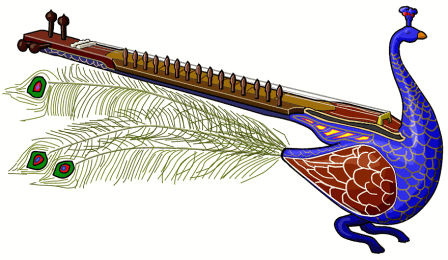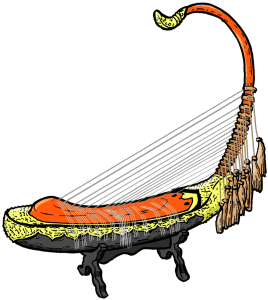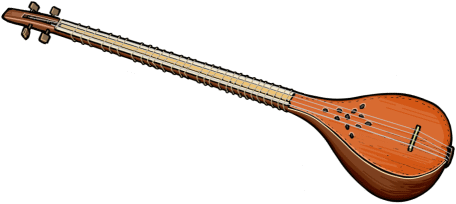User:ApeKattQuest, MonkeyPython/Spike-fiddles and other Riddles: Difference between revisions
| Line 189: | Line 189: | ||
<td>Kyl kyyak [https://www.wikidata.org/wiki/Q13170382 wd] [https://ky.wikipedia.org/wiki/%D0%9A%D1%8B%D0%BB_%D0%BA%D1%8B%D1%8F%D0%BA ky] [https://en.wikipedia.org/w/index.php?title=Kyl_kyyak&oldid=257894745 en] mb!</td> |
<td>Kyl kyyak [https://www.wikidata.org/wiki/Q13170382 wd] [https://ky.wikipedia.org/wiki/%D0%9A%D1%8B%D0%BB_%D0%BA%D1%8B%D1%8F%D0%BA ky] [https://en.wikipedia.org/w/index.php?title=Kyl_kyyak&oldid=257894745 en] mb!</td> |
||
<td>Cell 2</td> |
<td>Cell 2</td> |
||
</tr> |
|||
<tr> |
|||
<td>rabab</td> |
|||
<td>Cell 2</td> |
|||
</tr> |
|||
<tr> |
|||
<td>Chikara [https://www.wikidata.org/wiki/Q5097384 wd] [https://en.wikipedia.org/wiki/Chikara_(instrument) en] [https://tickets.metabrainz.org/browse/INST-955 jira]</td> |
|||
<td>http://web.archive.org/web/20191220143300if_/https://digitalstamp.suppa.jp/musical_instruments_c/chikara.jpg</td> |
|||
</tr> |
|||
<tr> |
|||
<td>sarod</td> |
|||
<td>http://web.archive.org/web/20160511013835if_/https://saisaibatake.ame-zaiku.com/gakki/imgi/sarod_i.gif</td> |
|||
</tr> |
|||
<tr> |
|||
<td>'''Sursingar''' [https://www.wikidata.org/wiki/Q2372387 wd] [https://en.wikipedia.org/wiki/Sursingar en] [https://musicbrainz.org/instrument/efca0287-2791-4209-b29b-1019891cb8d2 mb] hybrid plucked north indian classical lute invented c1800 by jaffar khan (seniya family)<br> |
|||
resonator, front and bridge from sitar, upperpart of neck/pegboard like the '''rabab''', tuned and played like '''rabab''', plectrum like sitar.<br> |
|||
(clearly this is a sitar/rabab hybrid)<br></td> |
|||
<td>http://web.archive.org/web/20200206002205if_/https://saisaibatake.ame-zaiku.com/musical/instruments/sursringar_i.jpg</td> |
|||
</tr> |
|||
<tr> |
|||
<td>'''sitar''' [https://www.wikidata.org/wiki/Q229205 wd] [https://en.wikipedia.org/wiki/Sitar en] [https://musicbrainz.org/instrument/9290b2c1-97c3-4355-a26f-c6dba89cf8ff mb] <br> |
|||
hindustani sitar seems to have more in common with large uzbek dutar [https://www.wikidata.org/wiki/Q1143814 wd] [https://en.wikipedia.org/wiki/Dutar en] [https://musicbrainz.org/instrument/b3cf8cff-f7c7-4311-bf4e-cfc09bdb07ca mb] than persian setar [https://www.wikidata.org/wiki/Q1544746 wd] [https://en.wikipedia.org/wiki/Setar en] [https://musicbrainz.org/instrument/f1299271-c5d7-4f7c-8b72-d64aa152c3bb mb]<br> |
|||
sitar and souther tambura [https://www.wikidata.org/wiki/Q3541715 wd] [https://en.wikipedia.org/wiki/Tanb%C5%ABra_(lyre) en] MB! (how relates to drone tanbura? [https://www.wikidata.org/wiki/Q1164636 wd] [https://en.wikipedia.org/wiki/Tanpura en] [https://musicbrainz.org/instrument/a19ae157-702a-40c6-892f-9bcb97328b7b mb]) to be evolved from the dutar?<br> |
|||
also Sarasvati vina from this?<br> |
|||
sitar has frets, tambura not<br> |
|||
terms "fretted and unfretted tambura" used to distinguish between sitar and fretless drone taMbura<br> |
|||
:: sursotta (transportable drone tambura)<br> |
|||
other sitar types: (distribution and related features suggest a common development)<br> |
|||
carnatic sitar<br> |
|||
kashmiri setar<br> |
|||
afghan tanbur<br> |
|||
gujarati sittarae(poss)<br> |
|||
<br> |
|||
modern:<br> |
|||
most common: <u>Hindustani concert sitar</u> aka tarafdar sitar (singel gourd and duble gourd)<br> |
|||
: has sympathetic strings, this is mostly commonly just called sitar and is the standard made <br> |
|||
<u>sada sitar</u> (plain or practice sitar)<br> |
|||
<u>kachva sitar</u> muhammad khan developed the surbahar from this, name probably a ref to the part of the gourd its used from.<br> |
|||
small sitar (kinnari veena)<br> |
|||
carnatic sitar<br></td> |
|||
<td>http://web.archive.org/web/20160417012026if_/https://digitalstamp.suppa.jp/musical_instruments_s/sitar.gif</td> |
|||
</tr> |
|||
<tr> |
|||
<td>kachva sitar aka kacchapi vina</td> |
|||
<td>Cell 2</td> |
|||
</tr> |
|||
<td>surbahar [https://www.wikidata.org/wiki/Q980383 wd] [https://en.wikipedia.org/wiki/Surbahar en] [https://musicbrainz.org/instrument/1ed558ad-1628-4e5f-8d14-e18e54375cd5 mb]<br> |
|||
effectively a bass sitar. invented c1820 by ghulam muhammad<br></td> |
|||
<td>Cell 2</td> |
|||
</tr> |
|||
<tr> |
|||
<td>tanpura aka tambura aka tanpur (etc)</td> |
|||
<td>http://web.archive.org/web/20140603224228if_/https://saisaibatake.ame-zaiku.com/gakki/imgi/tanpura_ia.gif</td> |
|||
</tr> |
|||
<tr> |
|||
<td>hansa veena<br> |
|||
?(novelty)</td> |
|||
<td>http://web.archive.org/web/20200206001429if_/https://saisaibatake.ame-zaiku.com/gakki/imgi2/hansa_veena.png</td> |
|||
</tr> |
|||
<tr> |
|||
<td>pulluvan veena [https://www.wikidata.org/wiki/Q55525195 wd] [https://de.wikipedia.org/wiki/Pulluvan_vina ge] mb!</td> |
|||
<td>http://web.archive.org/web/20200206001442if_/https://saisaibatake.ame-zaiku.com/gakkipedia/img/pulluvan-veena.gif</td> |
|||
</tr> |
</tr> |
||
<tr> |
<tr> |
||
| Line 261: | Line 199: | ||
</tr> |
</tr> |
||
<tr> |
<tr> |
||
<td> Dramyin, Tungana, Sgrna-snyan [https://beta.musicbrainz.org/instrument/ab0ed8e9-c02e-4824-bf1a-c8bb06f7cfe9 mb]<br> |
|||
<td> Dramyen (Damyan, Dranyen, Dramyin, Tungana)<br> |
|||
<br> |
<br> |
||
Folk rabab found in the Himalayas. The number of strings varies from 4, 5, 6, or 7. The name also varies, where local versions may be called Damyan, Dramyen, Dranyen, Dramyin (curiously sometimes spelled <u>sgrna-snyan</u>), or Tungana. Manuscripts from the Moghul period indicate that once this form of rabab was very common in northern India.</td> |
|||
<td>http://web.archive.org/web/20200317134335if_/https://digitalstamp.suppa.jp/musical_instruments_s/sgra_snyan.gif</td> |
<td>http://web.archive.org/web/20200317134335if_/https://digitalstamp.suppa.jp/musical_instruments_s/sgra_snyan.gif</td> |
||
</tr> |
</tr> |
||
Revision as of 20:08, 18 March 2020
How many r*b*b's do we have?:
long-necked rabab (spikefiddle rebab)
lute like ____ where the rebec evolved from (herein the lutes)
double chested rabab (pearshaped lute rubab)
So:
- Spikefiddle, to wit the ghijak wd en mb and the Indonesian Rebab belong...
- Long necked barbed lute (pearshaped lutes!) kamanche, ravaj, read vina
- Short necked fiddle boat-shaped /double chested lutes, herein the sarinda and sarangi families.
Classification aspect
spikefiddle - long neck, tiny soundbox
- Indonesian rebab
- đàn gáo
- đàn hồ
- đàn nhị
- salo/saw lo
- saw sam sai
- saw u
- saw duang
- tro khmer
- tro sau
- tro che
- tro sau thom
- tro u
- tro (research)
- jawza
- konya
- sanxian
- erxian
- huqin (family)
- sihu
- yehu
- dihu
- zhonghu
- banhu
- huluhu
- jinghu
- erhu
- gaohu
- kamancheh
- igil/ikili
- sanshin
- shamisen
- kokyu
- yaylı tambur
- ghijak
- ravanahatha
- haegeum
- (afrikan)
- goje
- njarka
- n'ko
- imzad
bowl (lyra, divergent) larger lute-like soundbox shorter neck
- Byzantine lyra/lira
- Gadulka
- gudok
- gusle
- sintir
- guimbri
- cretan lyra
- calabrian lira
- dalmatian lijerica
- kemenche
- pontic lyra(k of the black sea)
- politiki lyra (classical k)
- rebec
- rabel
- dutar
- çifteli
- cobza
- kobza/bandurka
- komuz
- qanbūs/gambus
- gabusi
- tambouras -> eg lutes, baglamas etc.
- pandur etc
- tambur etc
- tanpura etc
- indian lute, sitar
- cittern, gitten, etc guitar
- etc
double (lute, divergent) two bodied or hollowed out, concave shape, thick short neck
- kobyz
- rubab/rabab (kabuli rebab)
- sarod
- sarangi
- nepalian sarangi (is this really a separate instrument?)
- sarinda
- esraj
- dilruba
- ghaychak
- kyl kyyak
- lyra viol
- viol da gambas
- viol da braccios
- etc
harplike/veena
- taus/mayuri veena/b
- yazh
- saung/saung-gauk
lyre like
- crwth
- rotta
Notes
Rababah - ancient - arabic fiddle -
rebab - medieval - persia
seni rebab - medieval -
kabuli rebab - medieval - arab
rebec - medieval - europe
rebab - modern - indonesia
some interesting https://hu.wikipedia.org/wiki/Reb%C3%A1b_(egy%C3%A9rtelm%C5%B1s%C3%ADt%C5%91_lap)
Table Aspect
| Cell 1 | Cell 2 |
| sarangi wd en mb hindustani classical music, rajasthani folk sarangi, |
 |
| sarinda wd en jira, is related to and may derive from central asian shamans-fiddle qobuz (kobys?) widespread:
rajasthan (surinda) three main strings
manipur north-east india (sananta)
|
 |
| nepali sarangi wd en MB!(?) type of lute, evolved from the <strikeout>rabab</strikeout> includes this and the |
 |
| ghaychak wd en mb jira | cell 2 |
| in its family evolved from the kobyz wd en jira. (kobyz, ghaychak, sarangi) |
 |
| dhodro banam aka Santal lute east & north india (dhodro banam) |
cell 2 |
| Kyl kyyak wd ky en mb! | Cell 2 |
| Cell 1 | Cell 2 |
| Cell 1 | Cell 2 |
| Dramyin, Tungana, Sgrna-snyan mb
|
 |
| Cell 1 | Cell 2 |
| dotara |  |
| svaraj fretless long necked plucked lute from bangladesj, it is a bangl version of the bengali/northindian dotara, it ought to be spelled saraj (see esraj) | Cell 2 |
| esraj a kind of cross between sitar and sarangi, it is a modern variant of dilruba[1] |
 |
| Mandar Bahar nmm wd? mb! bass esraj |
Cell 2 |
| dilruba Dilruba is a compacter, mobiler instrument, is based on the heavier Taus[2] |
 |
| taus |  |
| mayuri-vina |
 |
| yazh |  |
| saung gauk |  |
| Cell 1 | Cell 2 |
| ektara (actually gopichant) |   |
| ektar (actually tumbi) |  |
| dutar |  |
| setar |  |
| bin-sitar | Cell 2 |
| kamaica | Cell 2 |
| ravanhattha |  |
| khuur (mongolian fiddles) |  |
| Cell 1 | Cell 2 |
.....
sara
surs
suba
sita
saro
sari
banam(rebs)
rabab-> sarod
https://timesofindia.indiatimes.com/From-Tri-tantri-Veena-to-Sitar/articleshow/21391436.cms and images on https://en.wikipedia.org/wiki/Tritantri_vina and https://en.wikipedia.org/wiki/Setar (compare image on https://en.wikipedia.org/wiki/Sitar ) makes it clear that it is the setar that is evolved from the tritantri veena - the sitar https://beta.musicbrainz.org/instrument/9290b2c1-97c3-4355-a26f-c6dba89cf8ff/ an unrelated (but possible distant cousin) was *named* after the Persian setar.